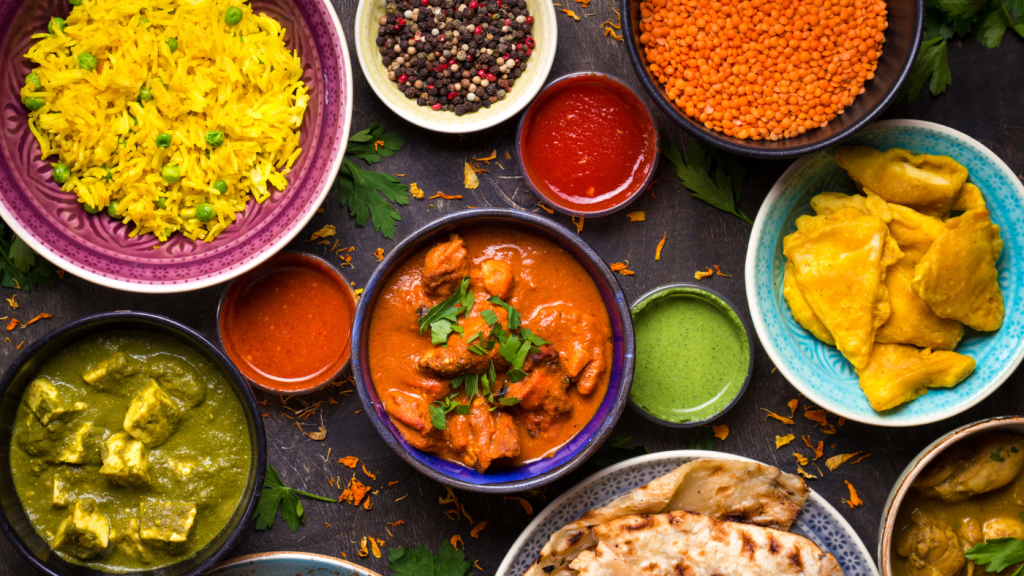Cuisine is a reflection of culture, history, and geography. It creates a unique identity for each region. Indian and American cuisines are both celebrated worldwide. They stand as testimonials to the diverse flavors and culinary traditions found across the globe.
In this article, we will delve into the fascinating differences that distinguish Indian and American cuisines, exploring the ingredients, cooking techniques, and cultural influences that shape these rich culinary landscapes.
Flavors and Spices
One of the most striking differences between Indian and American cuisines lies in the flavors and spices used. Indian cuisine is renowned for its bold and diverse use of spices, creating intricate and layered tastes in every dish.
Common spices include cumin, coriander, turmeric, cardamom, and garam masala, which are combined in various proportions to achieve harmonious balance of flavors. The use of spices in Indian cooking not only imparts distinctive tastes but also provides numerous health benefits.
On the other hand, American cuisine tends to favor a simpler approach, with a focus on the natural flavors of ingredients. Herbs like parsley, thyme, rosemary, and basil are commonly used, but spices are generally less prominent compared to Indian dishes. American cuisine often relies on techniques such as grilling, roasting, and smoking to enhance the natural taste of meats and vegetables.
Staple Ingredients
The staple ingredients in Indian and American cuisines also differ significantly, reflecting the availability of resources and historical dietary preferences. In Indian cuisine, rice and various types of lentils are fundamental components of meals.
The diverse range of bread, including naan, roti, and paratha, is another crucial element. Vegetables, pulses, and dairy products like yogurt also play a central role in creating well-rounded and nutritious Indian meals.
In contrast, American cuisine often centers around staples such as potatoes, corn, and wheat. Meat, particularly beef and poultry, holds a prominent place on the American dinner table. The diversity of American cuisine is further enriched by regional specialties, like Southern grits, Texan barbecue, and New England clam chowder. These all showcase the country’s geographical and cultural variations.
Culinary Techniques
Cooking techniques employed in Indian and American cuisines contribute to their distinct flavors and textures. Indian cuisine is characterized by a wide array of cooking methods, including sautéing, frying, roasting, and slow cooking.
The intricate process of tempering spices, known as “tadka,” is a common practice to infuse aromatic flavors into the dishes. Additionally, the use of clay ovens (tandoors) for baking bread and grilling meats is a traditional technique that imparts a unique smokiness to Indian cuisine.
On the other hand, American cooking often involves grilling, smoking, and barbecuing, especially in regions with a strong barbecue tradition. Baking, roasting, and frying are also prevalent methods. The emphasis on simplicity and allowing the natural flavors of ingredients to shine through is a hallmark of American culinary techniques.
Regional Diversity
Both Indian and American cuisines exhibit incredible regional diversity, influenced by local ingredients, climate, and cultural traditions. In India, each state boasts its own distinctive culinary identity.
For example, the fiery and aromatic dishes of Punjab contrast with the coconut-infused delicacies of Kerala. The use of seafood is prevalent in coastal regions, while vegetarianism is more pronounced in certain northern states.
Similarly, the United States showcases a diverse culinary landscape, with each region contributing unique flavors. Southern cuisine is known for its comfort food, featuring dishes like fried chicken, biscuits, and gumbo.
The Southwest embraces Mexican-inspired flavors, incorporating ingredients like chili peppers and cilantro. The Northeast, with its maritime influence, offers an abundance of seafood dishes, including clam chowder and lobster rolls.
Cultural Influences
The cultural influences shaping Indian and American cuisines further contribute to their distinctiveness. Indian cuisine reflects a rich history of trade, invasions, and diverse cultural influences.
The Mughals, Persians, and British, among others, have left indelible marks on Indian culinary traditions. The use of spices, cooking techniques, and the concept of combining sweet and savory flavors can be traced back to these historical influences.
In contrast, American cuisine has been shaped by a melting pot of cultures brought together by immigration. Native American, European, African, and Asian culinary traditions have all played a role in shaping the diverse food landscape of the United States.
The fusion of flavors, such as the incorporation of Italian pasta, Mexican spices, and Asian stir-frying techniques, has given rise to the eclectic and innovative nature of American cuisine.
In the vast tapestry of global cuisines, Indian and American culinary traditions stand out as vibrant, diverse, and reflective of their respective cultures. While Indian cuisine dazzles with its bold spices, intricate flavors, and rich history, American cuisine captivates with its simplicity, regional diversity, and multicultural influences.
Exploring the differences between these two remarkable culinary worlds provides a deeper understanding of the unique stories told through the art of cooking, inviting us to savor the richness and diversity that both Indian and American cuisines bring to the global table.

Toni’s Cookbook
Indian and American cuisine showcases the richness of the various cuisines of the world. That richness is something that Toni has experienced.
Toni is a traveling nurse who has been cooking for more than 50 years. That gives her enough experience to be an authority when it comes to cooking. Recently, she was blessed enough to train a colleague from India on how to cook Southern dishes. That was a revelation for her which led her to write a cookbook.
Help Toni to get her cookbook published! Click here: https://givebutter.com/Toni






